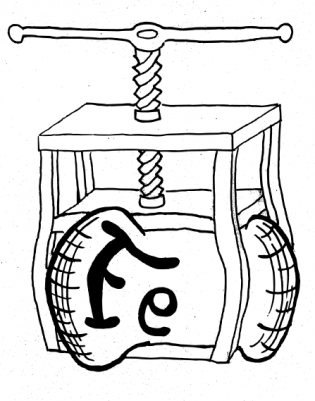The strain allows to control the magnetic properties of individual iron atom
2016-01-28

The iron Fe2+ atom embedded in a semiconductor exhibits a single non-degenerate ground state of zero magnetic moment. A team of scientists from the University of Warsaw has just shown that by using sufficiently large strain it is possible to tailor the energy spectrum of the iron atom to obtain doubly degenerate (magnetic) ground state. Such a state can be utilized for storage and processing of the quantum information. This discovery has been just published in prestigious research journal of Nature Communications [T. Smoleński et al., Nature Commun. 7, 10484 (2016)]
As the water freezes in a bottle, the molecules move farther apart from each other, which results in a strain that eventually may shatter the glass. Similarly, different crystals that are fused together might be stressed as if they would be compressed or stretched by a pressure many times larger than the pressure at the bottom of ocean. The macroscopic bulk crystals cannot withstand such a high stresses, which cause dislocations or even may break the crystals apart. However, a nanometer size crystals, nanocrystals, are able to sustain such a built-in stress, which substantially modifies the physical properties of the atoms embedded inside these nanocrystals. This phenomenon has been already employed, for example, to optimize the transistor operating speed by integrating nanostructures of different interatomic distances.
Tomasz Smoleński and co-workers from the Faculty of Physics, University of Warsaw have examined how the properties of the iron atoms are affected by the high strain produced by semiconductor nanostructures. Although the iron is usually associated with magnetism, it is known already from the 60’s that the iron atom of 2+ charge state becomes non-magnetic after incorporation into a typical semiconductor. To be more specific, the d-shell electrons of the iron atom have only one lowest-energy configuration, in which the total magnetic moment of the iron vanishes, even upon the application of a small external magnetic field. It turned out, however, that under the influence of a sufficiently large strain the energy spectrum of the iron electronic states is qualitatively different and comprises two lowest-energy spin states. As a consequence, non-zero magnetic moment of the iron atom placed in a strained environment can be easily induced by a tiny magnetic field. This discovery has been just published in prestigious research journal of Nature Communications [1].
Both the experiment and theoretical modeling have been carried out at the University of Warsaw. Using molecular beam epitaxy, Tomasz Smoleński and co-workers fabricated zinc selenide crystals integrated with cadmium selenide nanocrystals of larger lattice constant. This led to the growth of highly-strained cadmium selenide quantum dots embedded in a zinc selenide barrier. Additionally, an appropriately adjusted amount of the iron atoms was added during the formation of the quantum dots, so that some of them contained exactly one iron atom. The presence of such an atom, owing to its magnetic properties, modified the character of the light emission from such quantum dots. Therefore, by means of the photoluminescence studies of a single quantum dot containing an individual iron atom it was possible to determine both the electronic configuration and the magnetic properties of the iron atom. Furthermore, it was also found that the magnetic moment of this atom can be induced by light. Consequently, the new system – a quantum dot with a single iron atom – has become next excellent candidate for applications involving storage and manipulation of the quantum information both in the field of spintronics – electronics utilizing spins instead of electric charges, and solotronics – optoelectronics based on solitary dopants.
Physics and Astronomy first appeared at the University of Warsaw in 1816, under the then Faculty of Philosophy. In 1825 the Astronomical Observatory was established. Currently, the Faculty of Physics' Institutes include Experimental Physics, Theoretical Physics, Geophysics, Department of Mathematical Methods and an Astronomical Observatory. Research covers almost all areas of modern physics, on scales from the quantum to the cosmological. The Faculty's research and teaching staff includes ca. 200 university teachers, of which 88 are employees with the title of professor. The Faculty of Physics, University of Warsaw, is attended by ca. 1000 students and more than 170 doctoral students.
SCIENTIFIC PAPERS:
[1] Magnetic ground state of an individual Fe2+ ion in strained semiconductor nanostructure, T. Smoleński, T. Kazimierczuk, J. Kobak, M. Goryca, A. Golnik, P. Kossacki, W. Pacuski, Nature Communications 7, 10484 (2016).
http://www.nature.com/ncomms/2016/160128/ncomms10484/full/ncomms10484.html
This study was supported by National Science Centre, National Centre for Research and Development, Ministry of Science and Higher Education, and Foundation for Polish Science.
CONTACTS:
Tomasz Smoleński
Institute of Experimental Physics, Faculty of Physics, University of Warsaw
tel. +48 22 5532706
email: Tomasz.Smolenski@fuw.edu.pl
Tomasz Kazimierczuk
Institute of Experimental Physics, Faculty of Physics, University of Warsaw
tel. +48 22 5532711
email: Tomasz.Kazimierczuk@fuw.edu.pl
Wojciech Pacuski Institute of Experimental Physics, Faculty of Physics, University of Warsaw
tel. +48 22 5532707
email: Wojciech.Pacuski@fuw.edu.pl
RELATED LINKS:
http://www.fuw.edu.pl
Faculty of Physics at the University of Warsaw website.
http://www.fuw.edu.pl/informacje-prasowe.html
Press Office for the Faculty of Physics at the University of Warsaw.
IMAGES:
FUW160128b_rys01s.png, HR: http://www.fuw.edu.pl/press/images/2016/FUW160128b_rys01.png
The iron Fe2+ atom embedded in a semiconductor exhibits a single non-degenerate ground state with zero magnetic moment. A team of scientists from the University of Warsaw has just shown that by using sufficiently large strain (which is visualized here as an effect of a machine press) it is possible to tailor the energy spectrum of the iron atom to obtain doubly degenerate (magnetic) ground state. Such a state can be utilized for storage and processing of the quantum information. This discovery has been just published in prestigious research journal of Nature Communications [T. Smoleński et al., Nature Commun. 7, 10484 (2016)]. (Source: FUW, A. Bogucki)





